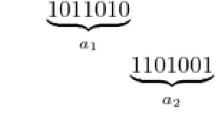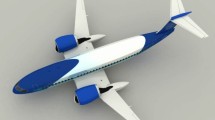Abstract
The multidisciplinary design optimization (MDO) is an important concept that focuses on bringing together disciplines involved with machine design. It is possible to use MDO in any stage of an aircraft design, that is in the conceptual, preliminary, or detailed design, as long as the numerical models are fitted to each of these stages. This work describes the development of a multidisciplinary design optimization applied to flexible aircraft wings, with respect to structural and aeroelastic characteristics. As tools for the aircraft designer, the numerical models must be fairly accurate and fast. Therefore, metamodels for the critical flutter speed prediction of aircraft wings were considered, thereby reducing significantly the computational cost of the optimization. For this purpose, artificial neural networks (NN) metamodeling is evaluated, based on their inherent properties in dealing with complex mappings. The NN metamodel is prepared using an aeroelastic code based on finite-element model coupled with linear potential aerodynamics. Results of the metamodel performance are presented, from where one can note that the NN is well suited for flutter prediction. Multiobjective optimization (MOO) using the genetic algorithm (GA) based on non-dominance approach is considered. The objectives were the maximization of critical flutter speed and minimization of structural mass. One case study is presented to evaluate the performance of the MOO, revealing that overall optimization process actually achieves the search for the Pareto frontier.













Similar content being viewed by others
References
Anderson MB, Gebert GA (1996) Using pareto genetic algorithms for preliminary subsonic wing design. In: Proceedings of the 6th AIAA/USAF/NASA/ISSMO symposium on multidisciplinary analysis and optimization, Bellevue
Antoine NE, Kroo IM (2005) Framework for aircraft conceptual design and environmental performance studies. AIAA J 43(10):2100–2109
Bishop JA, Eastep FE, Striz AG, Venkayya VB (1998) Influence of model complexity and aeroelastic constraints on multidisciplinary optimization of wings. J Aircr 35(5):784–790
Caixeta PR Jr, Marques FD (2009) Dynamic aeroelasticity constraints in multidisciplinary design optimization of flexible wings. In: Proceedings of the xiii international symposium on dynamic problems of mechanics—DINAME 2009, Angra dos Reis
Caixeta PR Jr, Marques FD (2010) Neural network metamodel-based MDO for wing design considering aeroelastic constraints. In: 51st AIAA/ASME/ASCE/ AHS/ASC structures, structural dynamics, and materials conference, Orlando. https://doi.org/10.2514/6.2010-2762
Caixeta PR Jr, Marques FD (2011) Metamodeling studies for flutter prediction of wings. In: Proceedings of the XIV international symposium on dynamic problems of mechanics—DINAME 2011, Spo Sebastipo
Cavagna L, Ricci S, Travaglini L (2011) NeoCASS: an integrated tool for structural sizing, aeroelastic analysis and MDO at conceptual design level. Prog Aerosp Sci 47(8):621–635. https://doi.org/10.1016/j.paerosci.2011.08.006
Craig RR (1981) Structural dynamics. Wiley, New York
De Baets PWG (2004) A methodology for aeroelastic constraint analysis in a conceptual design environment. PhD thesis, School of Aerospace Engineering, Georgia Institute of Technology
Deb K (2001) Multi-objective optimization using evolutionary algorithms. Wiley, Chichester
Deb K, Agrawal S, Pratap A, Meyarivan T (2000) A fast elitist non-dominated sorting genetic algorithm for multi-objective optimization: Nsga-ii. Tech. rep., Indian Institute of Technology Kanpur—Kanpur Genetic Algorithms Laboratory (KanGAL), Kanpur, India, technical Report 200001
Goldberg DE (1989) Genetic algorithms in search, optimization, and machine learning. Addison-Wesley Publishing Company Inc., New York
Hagan MT, Demuth HB, Beale MH (1996) Neural network design. PWS Publishing Co., Boston
Haykin S (1999) Neural networks: a comprehensive foundation. Prentice-Hall Inc, Upper Saddle River
Hodges DH, Pierce GA (2002) Introduction to structural dynamics and aeroelasticity. Cambridge University Press, New York
Janardhan S, Grandhi RV (2004) Multidisciplinary optimization of an aircraft wing/tip store configuration in the transonic regime. Eng Optim 36(4):473–490
Kapania RK, Chun S (2004) Preliminary design of a structural wing box under a twist constraint part i. J Aircr 41(5):1230–1239
Liu JL (2005) Intelligent genetic algorithm and its application to aerodynamic optimization of airplanes. AIAA J 43(3):530–538
Long T, Liu L (2012) Comprehensive study of typical metamodel methods applied in aircraft multidisciplinary design optimization. Appl Mech Mater 110:3031–3039. https://doi.org/10.4028/www.scientific.net/AMM.110-116.3031
Marler RT, Arora JS (2004) Survey of multi-objective optimization methods for engineering. Struct Multidisc Optim 26:369–395
Mastroddi F, Tozzi M, Capannolo V (2011) On the use of geometry design variables in the MDO analysis of wing structures with aeroelastic constraints on stability and response. Aerosp Sci Technol 15(3):196–206. https://doi.org/10.1016/j.ast.2010.11.003
McKay MD, Beckman RJ, Conover WJ (1979) A comparison of three methods for selecting values of input variables in the analysis of output from a computer code. Technometrics 21(2):239–245. http://www.jstor.org/stable/1268522
Mullur AA, Messac A (2006) Metamodeling using extended radial basis functions: a comparative approach. Eng Comput 21(3):203–217
Österheld CM, Heinze W, Horst P (2000) Influence of aeroelastic effects on preliminary aircraft design. In: Proceedings of the ICAS 2000 congress, pp 146.1–146.10
Pineda LE, Fregly BJ, Haftka RT, Queipo NV (2010) Estimating training data boundaries in surrogate-based modeling. Struct Multidiscip Optim 42(6):811–821
Raymer DP (2002) Enhancing aircraft conceptual design using multidisciplinary optimization. PhD thesis, Department of Aeronautics, Royal Institute of Technology
Secco NR, Mattos BS (2017) Artificial neural networks to predict aerodynamic coefficients of transport airplanes. Aircr Eng Aerosp Technol 89(2):211–230. https://doi.org/10.1108/AEAT-05-2014-0069
Sobieszczanski-Sobieski J, Haftka RT (1997) Multidisciplinary aerospace design optimization: survey of recent developments. Struct Optim 14(1):1–23. https://doi.org/10.1007/BF01197554
Viana FAC, Steffen V Jr, Butkewitsch S, Leal MF (2009) Optimization of aircraft structural components by using nature-inspired algorithms and multi-fidelity approximations. J Glob Optim 45(3):427–449
Wang GG, Shan S (2007) Review of metamodeling techniques in support of engineering design optimization. J Mech Des 129(4):370–380. https://doi.org/10.1115/1.2429697
Acknowledgements
The authors acknowledge the financial support of the Brazilian Research Agencies, CNPq and FAPEMIG, for funding this present research work through the INCT-EIE (National Institute of Science and Technology in Smart Structures in Engineering), Grants #574001/2008-5 and #307658/2016-3.
Author information
Authors and Affiliations
Corresponding author
Additional information
Technical Editor: André Cavalieri.
Rights and permissions
About this article
Cite this article
Caixeta, P.R., Marques, F.D. Multiobjective optimization of an aircraft wing design with respect to structural and aeroelastic characteristics using neural network metamodel. J Braz. Soc. Mech. Sci. Eng. 40, 17 (2018). https://doi.org/10.1007/s40430-017-0958-7
Received:
Accepted:
Published:
DOI: https://doi.org/10.1007/s40430-017-0958-7




